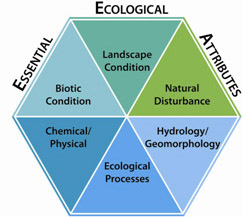Technical Elements of EPA’s Healthy Watersheds Program
The Healthy Watersheds Program Conceptual Framework

The Healthy Watersheds Program conceptual framework is a systems approach to identifying and protecting healthy watersheds, based on the dynamics and interconnectedness of aquatic ecosystems. The framework is consistent with recommendations by EPA’s Science Advisory Board (SAB) in its report entitled, A Framework for Assessing and Reporting on Ecological Condition (pdf) . The EPA SAB identified six essential ecological attributes (EEAs), to describe ecosystem condition. These include:
- landscape condition
- biotic condition
- chemical and physical characteristics
- ecological processes (e.g., energy and material flow)
- hydrologic and geomorphic condition
- natural disturbance regimes
Much of the Healthy Watersheds website is for technical audiences who may be planning or conducting a watershed assessment and need assistance in the form of methodologies, data/tools, case studies and published references. The following five sub-pages address the following topics:
Assessment Overview
Unless a healthy watersheds protection effort plans to address a few single watersheds one at a time, a comprehensive set of information is necessary to review all watersheds, identify potentially healthy ones, compare their values and their vulnerabilities, and take action on the highest priority places. This section describes the fundamentals of comprehensive healthy watersheds assessment as assembled and applied in an EPA-developed assessment methodology.
Watershed Health Index
The major task of a healthy watersheds assessment is to document key watershed attributes in a way that allows condition or health to be systematically compared across a group of watersheds. This section provides details and examples of how Healthy Watersheds assessment measures the six essential ecological attributes (see Assessment Overview section) as sub-indices and aggregates these into an overall Index of Watershed Health.
Watershed Vulnerability Index
An important complement to assessment of watershed health is assessment of the vulnerability of the watershed to various sources of degradation. Like the Health index, the Healthy Watersheds Vulnerability Index addresses and measures relevant risks to watershed condition from land use change, water use change, climate change, and others.
Protection Overview
There is no single, prescribed approach for healthy watersheds protection, but rather a wide array of actions, across local to national scales, across government and non-government partners, who collectively make watershed protection possible. This section contains an inventory of resources that may be helpful for readers interested in taking action to identify and protect healthy watersheds. The inventory lists available reports, guides, datasets, tools and initiatives that can inform approaches to assessing and protecting healthy watersheds or highlight organizations for forming partnerships.
Go to Watershed Protection Projects by State and Region
Reports and Publications
This section provides links to several EPA documents that have played a key role in the development and operation of the Healthy Watersheds Program.
